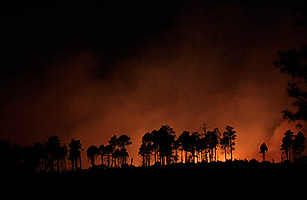
Residents across New Mexico might be wondering what they did to anger Mother Nature. Ever since 2011 arrived on the scene, the weather has been nothing but ugly, beginning with a terrifying winter and now terrifying fires with the nebulous possibility of nuclear contamination.
It began with a mass of arctic air in early February that sent temperatures plummeting to depths never seen in the state before. Pipes froze and many schools and government offices were closed to preserve gas supplies, which became so scarce that the New Mexico Gas Co. suspended service to some northern New Mexico communities, including Taos, in order to prevent the entire system from shutting down. The big freeze destroyed 99% of the state’s peach crop and damaged many other fruit crops.
Spring came late, bringing with it fierce winds that kicked up dust clouds so thick they obscured nearby mountains. Typically, the spring winds are gone by the end of May. But they are still raging. And then there’s the rain problem, or the lack of it. Only 0.19 of an inch of moisture has fallen from the skies since last October, making this the driest period since 1897, when the state began keeping track. In the mountains outside Albuquerque, wild irises still managed to stage a bloom a month ago, and Fairy Slipper orchids peeked out next to stately ponderosa pines. But giant conifers lay on their sides, as if their parched roots couldn’t hold onto the earth any longer.
“I feel like part of this is just Mother Nature, and part of it is, ‘Oh Boy!,'” says Leanne Kiesling, who has lived in Cochiti Lake for the past 14 years. “You have to wonder about our carbon footprint.”
The outbreak in late May of the Wallow Fire in eastern Arizona was a harbinger of what was to come in New Mexico. Every evening for more than a week, a thick cloud of smoke from that fire settled over Albuquerque, 200 miles away. Some nights the smoke cloud was so thick it first turned the sun red, and then completely obliterated it, much like a winter snowstorm moving in. To live in Albuquerque then was like living inside of a campfire. The fortunate folks with respiratory problems headed for relatives’ homes in neighboring states, but others remained, forced inside with the windows shut. Thankfully, the temperatures hadn’t reached 100 degrees yet.
“It was eerie when the smoke was so thick,” says Charles LeBlanc. “We thought of putting a mask on our 18-month-old daughter, Charlotte, but given that she won’t even keep a hat on, we knew that wouldn’t work. We just kept her inside and didn’t run the air conditioner, which made for some uncomfortable nights.”
Now, with the temperatures hitting 100 degrees and the winds still whipping up to 50 mph some afternoons, the wildfires have made their way into New Mexico. Much of the state’s public land has been closed to hikers, including the national forests bordering both Albuquerque and Santa Fe. Nonetheless, a fire broke out in the forest north of Santa Fe more than a week ago and has grown to more than 10,000 acres. As the smoke from that fire billowed above Santa Fe on Sunday, another fire broke out in the Jemez Mountains, about 50 miles away.
The new Las Conchas Fire grew quickly and on Monday, the city of Los Alamos was evacuated, bringing back frightening memories from 2000, when the Cerro Grande wildfire destroyed more than 350 homes there. The Las Conchas Fire grew to more than 40,000 acres in two days, causing Los Alamos Fire Chief Doug Tucker to call it the most active fire he’d seen in his 42-year career. By comparison, the Cerro Grande fire took 12 days to destroy 45,000 acres.
So far, Los Alamos, along with the town’s reason for existing, the Los Alamos National Laboratory, has escaped the fire’s wrath. Law enforcement officers and National Guard vehicles creep along the city’s empty streets in their mission to keep it safe from looters. The fire has closed in on the laboratory’s boundaries, but has not made inroads. By Wednesday, the fire had destroyed 61,000 acres and was still raging out of control.
Lab spokesman Kevin Roark does not expect the fire to impact the lab or its sensitive materials. “Even prior to the Cerro Grande Fire, we had a program to reduce the fuel load by the lab,” he said. “And from that fire, we learned that we had to be more aggressive in thinning underbrush near chief facilities.” At Area G, where radioactive waste is stored in fire-resistant domes on cement pads, gravel and asphalt have replaced native vegetation and a sprinkler system serves as another layer of protection.
With the Fourth of July approaching and fireworks stands bustling with business, residents and officials are worried. If only they could get a word with Mother Nature, they would ask for one more record: to experience the wettest July ever in New Mexico.
See U.S. Nuclear ‘Near-Misses’ in 2010.
See TIME’s Pictures of the Week.